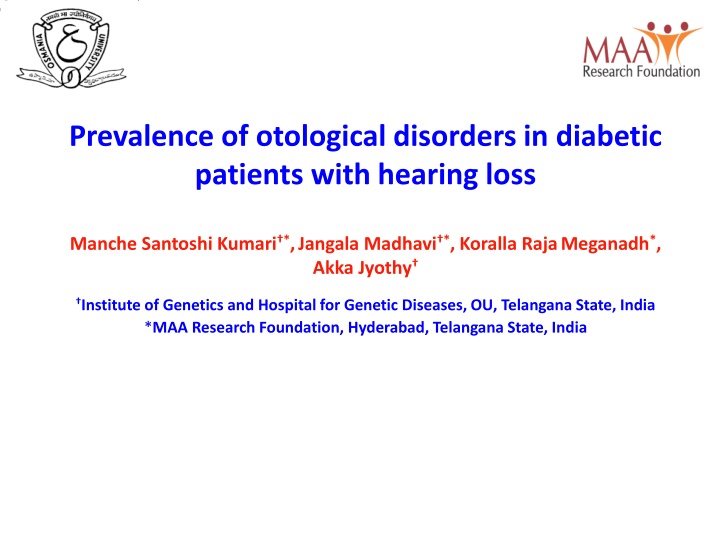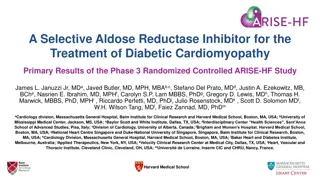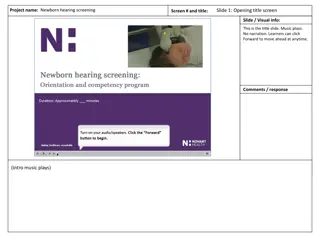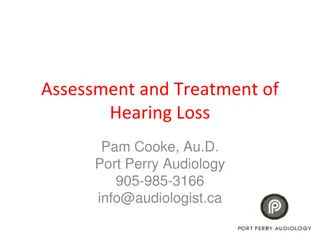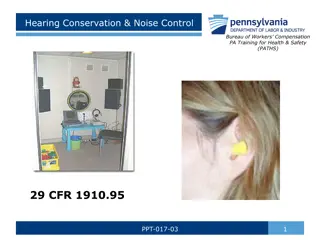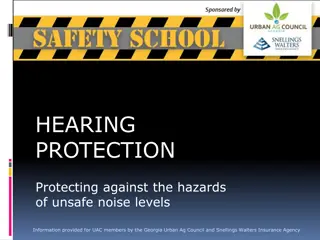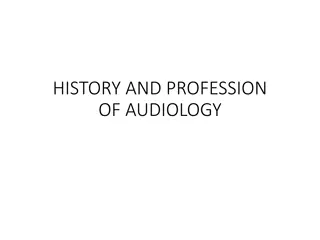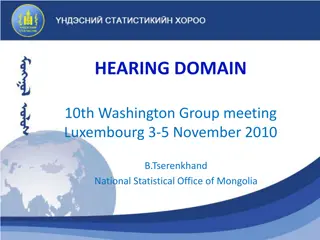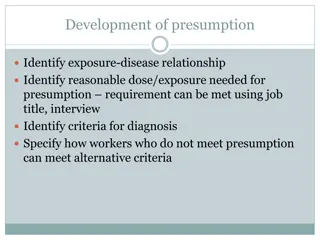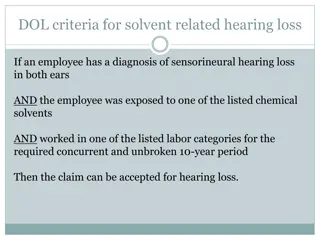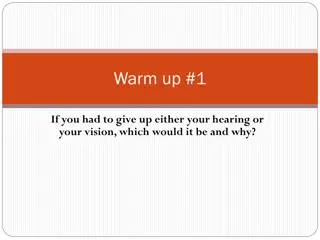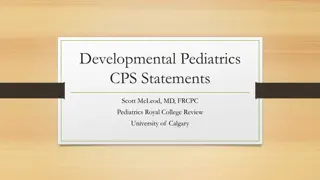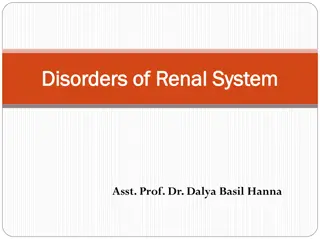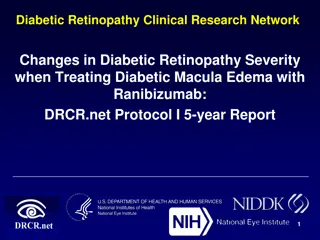Prevalence of otological disorders in diabetic patients with hearing loss
Otological disorders are common in diabetic patients with hearing loss due to the impact of diabetes on the auditory system. Diabetes mellitus is a global health concern leading to irreversible complications, including various ear diseases and conditions such as otitis externa, otosclerosis, and sensorineural hearing loss. Understanding the pathological changes caused by diabetes in the auditory system, particularly in structures like the cochlea and auditory nerve, sheds light on the increased prevalence of hearing loss in diabetic individuals. Alterations in glucose levels affect the inner ear, leading to a higher risk of developing conditions like presbycusis and sudden sensorineural hearing loss. The interplay between diabetes and otological disorders highlights the importance of early detection and management to prevent further complications.
Download Presentation

Please find below an Image/Link to download the presentation.
The content on the website is provided AS IS for your information and personal use only. It may not be sold, licensed, or shared on other websites without obtaining consent from the author.If you encounter any issues during the download, it is possible that the publisher has removed the file from their server.
You are allowed to download the files provided on this website for personal or commercial use, subject to the condition that they are used lawfully. All files are the property of their respective owners.
The content on the website is provided AS IS for your information and personal use only. It may not be sold, licensed, or shared on other websites without obtaining consent from the author.
E N D
Presentation Transcript
Prevalence of otological disorders in diabetic patients with hearing loss Manche Santoshi Kumari *,Jangala Madhavi *, Koralla RajaMeganadh*, Akka Jyothy Institute of Genetics and Hospital for Genetic Diseases, OU, Telangana State, India *MAA Research Foundation, Hyderabad, Telangana State, India
Diabetes mellitus Prevalence all over the globe is increasing at an alarming rate. India is the Diabetes capital of the world . Increased propensity for developing a broad spectrum of irreversible complications.
Diabetes with hearing loss Alterations in glucose levels affect nearly every organ system in the body. Affects the auditory system - leads to the onset of hearing loss. Prevalence of hearing loss in diabetic patients is increasing (Mitchell et al., 2009). Adapted from http://www.audiologyspecialists.com/anatomy-of-the-ear
Otological disorders Diseases of Ear Inner Ear External Ear Cerumen impaction Congenital ear anamolies Otitis externa Otomycosis Referred otalgia Middle Ear Acute suppurative otitis media Chronic suppurative otitis media Otitis media with effusion Otosclerosis Cervical vertigo Congential hearing loss Meniere s disease Presbycusis Sudden sensorineural hearing loss Traumatic lesions Ototoxicity
Sound transmission pathway Pinna Sound External ear Auditory canal Middle ear Tympanic membrane Mechanical energy Ossicles Oval window Inner ear Cochlea Hair cells Electrochemical energy Auditory nerve Brain Adapted from http://hsc.csu.edu.au/biology/options/communication/2954/CommPart6.html
Pathological changes caused by diabetes in the auditory system 1. Structures of the cochlea 2. Auditory nerve 3. Blood supply to cochlea 4. Central auditory processing Microvascular and neuropathic Nerve damage associated with changes in the cochlea auditory system Blood sugar level Blood Glucose levels Chemical changes Injury Inner ear Inner ear Impact Nerve ability to carry sound sound Vasculature 8th/cochlear/auditory nerve Sensorineural hearing loss
Hearing impairment Hearing impairment is a common sensory disability to comprehend sound in auditory pathway of one or both ears. Patterns of hearing loss: Conductive (outer and/or middle ear) Sensorineural (inner ear) Mixed (outer/ middle/inner ear) Central (brain stem lesions) Socio-economic Status Exposure to Ototoxic chemicals Physical Trauma Hearing Impairment Long term Exposure to environmental noise Medication Genetics Disease or Illness
Degree of hearing loss Degree of hearing loss Hearing loss range(dB HL) Normal -10 to 15 Minimal 16 to 25 Mild 26 to 40 Moderate 41 to 55 Moderately severe 56 to 70 Severe 71 to 90 Profound 91+ Source: Clark, J. G. (1981). Uses and abuses of hearing loss classification. Asha, 23, 493 500.
Importance of the study Hearing loss and diabetes (DM2) are significant health issues in the elderly population. Studies on hearing loss in diabetes have not received attention in South Indian population. For determining the magnitude and onset of hearing loss in diabetic population of South India.
Objectives To determine the demographic and otological parameters in diabetic subjects affected with hearing loss. To investigate the prevalence of otological diseases and hearing loss patterns in adults suffering from diabetes in South Indian population.
Subjects 174 diabetic cases affected with hearing loss and 420 non-diabetic constituted the study subjects MAA ENT Hospitals, Hyderabad, Telangana State, India Age >=40 years were included in the study. Confirmatory diagnosis was done by the general physician and ENT specialist. Otological examinations were carried out to diagnose the disorders. Hearing loss was evaluated using pure tone audiometry and average for the frequencies at 0.5,1,2,4 and 8 kHz was recorded.
Statistical Analysis The data obtained was coded for statistical evaluations. Analysis was performed using the Statistical Package for Social Sciences PASW STATISTICS 18.0 software (SPSS Inc., Chicago, IL, USA). Continuous data is represented as means and standard deviations. Categorical data as proportions and percentages for illustrations. Chi-square test and binary logistic regression analysis was used for evaluating the association of various parameters.
Table 1. Distribution of gender, age and otological parameters in diabetic and non diabetic study subjects OR(95% CI) Parameters Diabetic (n=174) Non-diabetic(n=420) Gender Female Male 182(43.3) 238 (56.7) 1.00(Reference) 1.45(1.03-2.04)* 60(34.5) 114(65.5) Age(years) Age of onset(years) 40-60 >60 58.3 11.36 56.2 11.31 108(62.1) 66(37.9) 55.5 11.47 54.4 10.62 307 (73.0) 113(26.9) NC NC 1.00(Reference) 1.65(1.17-2.32)** Laterality Unilateral Bilateral 1.00(Reference) 1.51(1.07-2.11)* 62(35.6) 112(64.4) 191(45.5) 229(54.5) Mean PTA(dBHL) <40dB >40dB 50.5 17.34 71(40.8) 103(59.2) 49.4 17.54 167(39.7) 253(60.3) NC 1.00(Reference) 0.95(0.68-1.33) Associated symptoms Tinnitus Vertigo a. -Independent sample t test(mean standard deviation); b. Values in paranthesis are percent frequency; NC-Not calculated. c. - Chi-square test 56(32.2) 24(13.8) 161(36.0) 69(15.3) 0.83(0.59-1.17) 0.97(0.60-1.56)
Table 2. Association of gender and otological parameters with age of onset in diabetic subjects affected with hearing loss Parameters Total 40-60 years >60 years P-value OR(95% CI) Gender Male Female 1.00(Reference) 0.49(0.26-0.96)* 114(65.5) 60(34.5) 59(51.8) 41(68.3) 55(48.2) 19(31.7) 0.036 Laterality Unilateral Bilateral 1.00(Reference) 2.43(1.26-4.67)** 2(35.6) 112(64.4) 43(44.3) 54(55.7) 19(24.7) 58(75.3) 0.007 Degree of hearing loss(Decibels-dB) <40 dB >40dB 10(13.0) 67(87.0) 1.00(Reference) 1.32(0.56-3.11) 26(14.9) 148(85.1) 16(61.5) 81(83.5) 0.519 Types of hearing loss Conductive hearing loss Sensorineural hearing loss Mixed hearing loss 1.00(Reference) 4.23(2.10-8.48)*** 0.95(0.38-2.37) 77(44.3) 67(38.5) 30(17.2) 24(31.2) 23(23.7) 9(11.7) 53(54.6) 44(57.1) 21(21.6) <0.001 a. Values in paranthesis are percent frequency b. -Chi-square test, , -binary logistic regression analysis
Figure 1. Prevalence of otological disorders in diabetic and non diabetic study subjects Diabetic Non diabetic 50 45 40 % Frequency 35 30 25 20 15 10 5 0
Figure 2. Distribution of otological diseases at different age groups in diabetic and non diabetic study subjects Diabetic Non-Diabetic 100 80 % Frequency 60 40 20 0 40 - 60 years >60 years
Figure 3. Prevalence of otological diseases in the study subjects with laterality in diabetic and non diabetic study subjects Diabetic Non diabetic 80 60 % Frequency 40 20 0 Unilateral Bilateral
Figure 4. Distribution of hearing loss patterns in otological diseases of diabetic and non diabetic study subjects Diabetic 100 Non- diabetic 90 80 70 60 50 % Frequency 40 30 20 10 0 Conductive hearing loss Sensorineural hearing loss Mixed hearing loss
Figure 5. Prevalence of hearing loss at lower(<40dB) and higher frequency (>40dB) in otological diseases of diabetic and non diabetic study subjects Diabetic Non diabetic 100 80 % Frequency 60 40 20 0 0-40 dB HL > 40 dB HL
Results Male preponderance(1.9) was observed. Prevalence of hearing loss was more in subjects >60 years of age (55.7%). Prevalence of bilateral hearing loss was more in diabetic subjects. 85.1% of study subjects showed hearing loss at higher frequency (>40 dBHL). Hearing loss was more prevalent in presbycusis (61.3%) and acute suppurative otitis media (27%)among diabetic cases. 32.2% of the diabetic subjects showed tinnitus. 44.3% of the diabetic subjects showed conductive type followed
by 38.5 % of sensorineural and 17.2% of mixed hearing loss. Association of hearing loss with age of onset of diabetes Bilateral form of hearing loss was observed to be more in subjects >60 years of age group. Sensorineural hearing loss was significantly associated with increase in age. Otological disorders Prevalence of presbycusis was predominant at higher age group. Bilateral form of hearing loss was noticed in Meniere s disease and presbycusis. Otitis media, otosclerosis and sudden sensorineural form of hearing loss showed unilaterality.
Sensorineural form of hearing loss was noticed to be high in Meniere s disease, OME and otosclerosis. Conductive hearing loss was noticed more in ASOM. Presbycusis, CSOM and OME were observed to have hearing loss at >40dBHL. Hearing loss at lower frequency (<40dBHL) was noticed at ASOM, otosclerosis and Meniere s disease.
Conclusion Presbycusis and otitis media were the predominant otological disorders found in diabetes patients with hearing loss. Sensorineural form of hearing loss was found to significantly associated with the elderly age group (>60 years). Conductive form of hearing loss was more prevalent in subjects suffering from ASOM. Sensorineural form of hearing loss was high in Meniere s disease, OME and otosclerosis. Hearing disability (>40dB) was more in otological disorders of otosclerosis, Meniere s disease and presbycusis ASOM and sudden sensorineural hearing loss showed prevalence even at lower decibel range(<40dB).
Significance of the study The study helped to establish the prevalence otological disorders to be more prevalent in diabetic subjects is caused by the dysfunction of middle and inner ear. Diabetes is associated with hearing disorders in above 60 years age group than between 40-60 years. Effective control of diabetes is to be considered to reduce the incidence of deafness in above 60 years.
Acknowledgement I would like to thank MAA Research foundation for the funding and Ms. B. Sunita G Kumar, CMD, MAA ENT Hospitals for her support and cooperation in carrying out the work. I would also thank J.V. Ramakrishna, D. Dinesh Babu and P. Padmavathi in providing valuable support in carrying out the work.
References Kakarlapudi V, Sawyer R, Staecker H. The effect of diabetes on sensorineural hearing loss. Otol Neurotol. 2003 May;24(3):382-6. Review. PubMed PMID: 12806288. Hong O, Buss J, Thomas E. Type 2 diabetes and hearing loss. Dis Mon 2013; 59: 139-46. Mitchell P, Gopinath B, McMahon CM, Rochtchina E, Wang JJ, Boyages SC, et al. Relationship of Type 2 diabetes to the prevalence, incidence and progression of age-related hearing loss. Diabet Med 2009; 26: 483-8. Malucelli DA, Malucelli FJ, Fonseca VR, Zeigeboim B, Ribas A, Trotta Fd, Silva TP. Hearing loss prevalence in patients with diabetes mellitus type 1. Braz J Otorhinolaryngol. 2012 Jun;78(3):105-15. English, Portuguese. PubMed PMID: 22714855. Taylor,I.G.,Irwin,J. Some audiological aspects of diabetes mellitus. J Laryngol Otol.1978;92:99-113. Cullen JR, Cinnamond MJ. Hearing Otol.1993;107(3):179-82. loss in diabetics. J Laryngol
